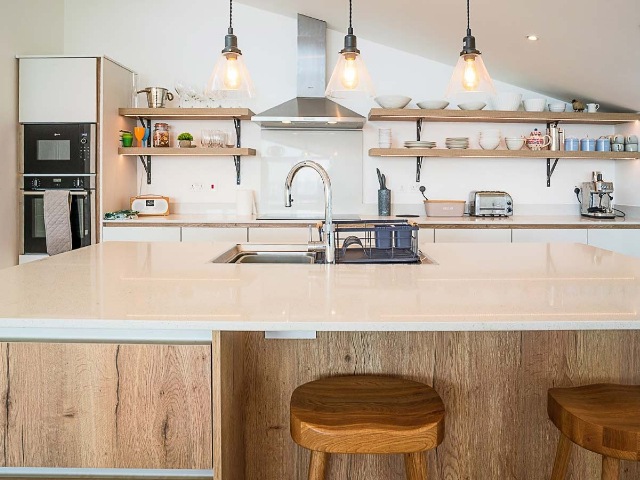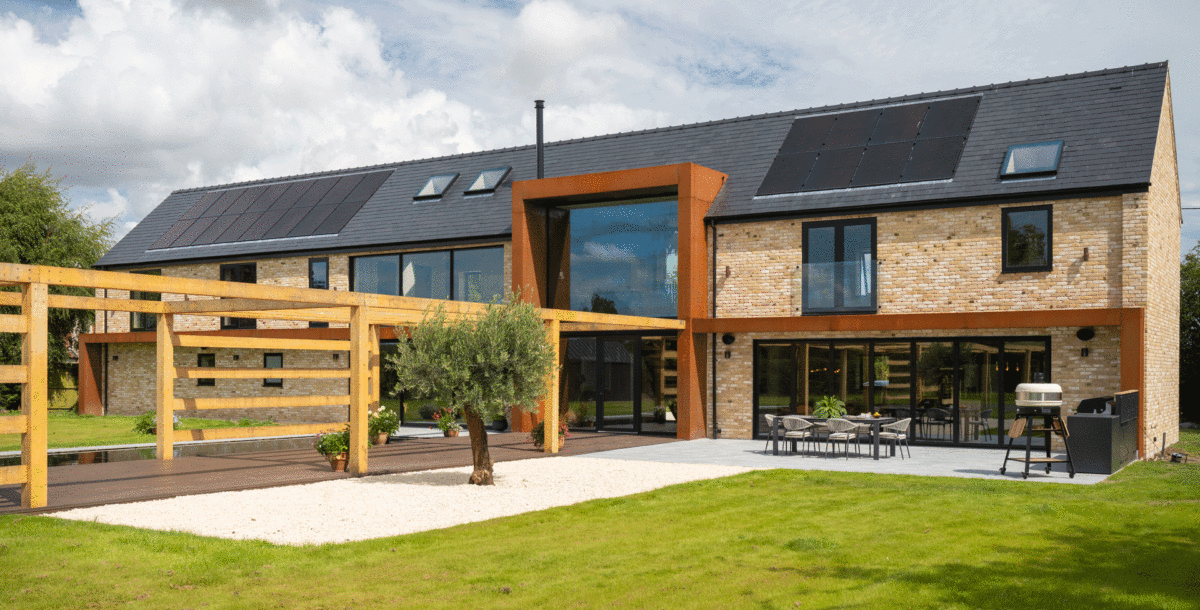In the 1950s, a Brooklyn Museum promoted Nordic designers’ Scandi furniture, and Scandi kitchens became a global phenomenon. Picture a Swedish kitchen with functional cabinets, organic materials and a minimalist approach – the hallmarks of a modern Scandi kitchen which are more popular than ever.
What makes this style loved? In short, these kitchens once catered for converging macro-trends. As communities urbanised, they gave homeowners practical storage but also minimalist furniture, providing somewhere they could cook and entertain. Somewhere that’s useful but also Instagrammable. The Scandi style had it all so has commandeered public imagination.
Today, millions covet the look but many still struggle to achieve it. Fortunately, the experts at Masterclass Kitchens have created thousands of Scandi ranges and created this guide. So, read on for an introduction to the concept, pitfalls to avoid and tips to achieve a flawless Scandi kitchen.

An H-Line Sutton Scots Gret and Ligna Mayfield Oak range by Tu Mewn
What’s the Difference Between Scandinavian and Nordic Décor?
To begin, it’s well worth differentiating “Scandinavian” and “Nordic” descriptors so you know what you’re trying to achieve. So, what’s the difference? Essentially, Scandinavia covers Sweden, Denmark and Norway. Nordic, meanwhile, refers to them, plus Iceland, Finland and Greenland. Scandi design borrows from all those cultures. As a result, we’ll use Nordic and Scandi interchangeably going forward..
Are Scandi Kitchens Always Cold?
It’s commonly misconceived that Scandi kitchens’ minimalistic features and pastel colours make them cold. In reality, though, they’re warm. Indeed, the minimalism is purely practical and, if done right, Scandi kitchen décor should express hygge, creating coziness that can hold off even a harsh Nordic winter.

A H-Line Lumina and Ligna range by Sigma 3 Kitchens Cardiff East
Take these Scandi home interior designs, for example. Showcasing warm tones, natural woods and deeper elements that perfectly capture the mid-century modern kitchen aesthetic, they’re warm and welcoming in spite of their ultra-practical, modern cabinetry.

A Ligna range by Sigma 3 Kitchens Esher
How to Create a Scandi Kitchen
Now that you understand the relevant terms and end goal for mastering Scandi interior design, it’s time to go deeper. So, let’s start with the fundamental components of a Scandi-style interior:
- lots of natural light
- a functional layout
- neutral colour palettes
- minimalist aesthetics
- high-quality craftsmanship
Can you break the rules? According to Masterclass designers, yes. Swedish homes often contrast Nordic furniture with ornate French architecture, for instance. For the time being, though, they recommend understanding the basics before you experiment. Now, for a breakdown of a Scandi kitchen from the bottom up.
Scandi-Style Kitchen Flooring
When it comes to flooring, it’s best to keep it wooden and exposed. Pale wood is popular. Darker is fine – as are tiles, but they rarely achieve the same finesse. Click-lock flooring is common but floorboards or parquet blocks will elevate your space if you have the budget. Just remember, never – NEVER – use wall-to-wall carpet if you want a Scandi kitchen.
Importantly, keep walkways clear. Doing so adds to the minimalist vibe that characterises most Scandi kitchens. Integrated kitchen bins are a fantastic way to achieve and maintain this goal.

A H-Line Sutton range by Ratford Bridge Kitchens
Flooring with warm brown wood lets you use white or light grey cabinetry without making the room feel cold. Even then, though, you needn’t contrast in this way. Perhaps add to the natural wood with matching cabinets, or flip the look with wood cabinets and whitewashed wood flooring for the same effect. Just ensure you stick to this colour palette to adhere to true Scandi design principles.
Scandi-Look Kitchen Doors
You’d be mistaken for thinking that all Nordic kitchens feature flat slab or handleless doors. Those features are common, yes, because they match the simple design of a Scandi dining table or armchair. However, classic, Shaker, modern and handleless kitchens can all create a Nordic design.

An H-Line Sutton and Ligna range by Tu Mewn
The finish is more important than the style. As mentioned, natural wood or white-washed cabinetry complements this look, whether you want a handleless kitchen or one with farmhouse elements. Whatever you choose, aim for minimal upper cabinetry to maximise light.

A Sutton range by Sigma 3 Kitchens Cardiff East
Nordic-Style Kitchen Worktops and Handles
As for the fixtures, clean lines are vital. Say you’re looking for the perfect Scandi-inspired kitchen handle. Handleless ridges or chunky wooden affairs with no fussy details are ideal. Likewise, you’d do well with a pattern-free worktop of natural-looking stone.

A Wimbourne range by Sigma 3 Kitchens Abergavenny and a Sutton range by New Forest Designs
Once you have those features in place, keeping surfaces clear is necessary to maintain simplicity. At Masterclass Kitchens, they specialise in high-quality kitchen storage and recommend their Hathaway pantry to aspiring Scandi kitchen owners because of its storage versatility and Portland Oak interior.
Scandi Home Décor Ideas
Bringing together the finishing touches of a Nordic interior floorplan that looks cozy isn’t easy but – don’t worry – the Masterclass team have you covered. Firstly, start with accessory colours. Pastel-coloured walls are largely a more reliable option than white because they help you avoid a clinical vibe.
Regarding chairs, the famous moulded plywood variety is a Scandi staple. Industrial pendant lights and chunky wooden bar stools similarly play a large role in achieving this iconic aesthetic.

An Ashbourne Olive and Farringdon Grey range by Moulton Kitchens
If you want to inject some vivid colour into your Nordic-style home décor, modern art sculptures or decorative light shades are easy targets for many modern Scandi kitchen owners. Alternatively, you could use one of Masterclass’s Breakfast Dresser and hang quirky, home-kilned mugs from its mug hooks.
Finally, remember that note about keeping the floor clear? Make an exception for soft furnishings because these are the pillars of hygge and will give your room warmth. Consider a well-placed rug, throws, cushions and upholstered armchairs. Interestingly, though, no curtains. Scandinavians prefer blinds or completely naked windows.
Need Help Creating a Scandinavian Kitchen?
Feeling inspired to get your own Norwegian, Danish or Swedish kitchen but don’t know where to start? If you need more help, find your nearest Masterclass showroom and book a meeting, or become a Masterclass Insider for free. As Masterclass Insider, you’ll get free design guides and tips you can’t get anywhere else.









